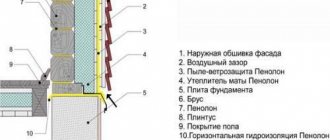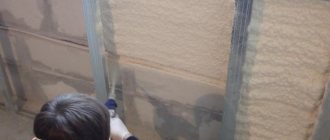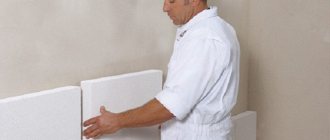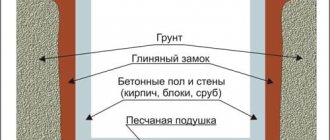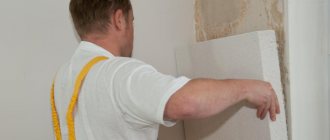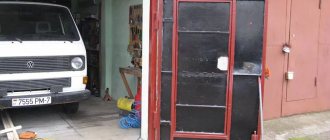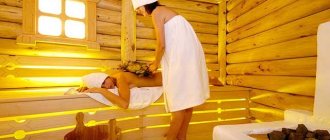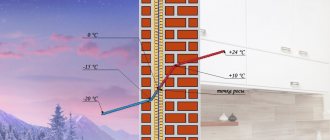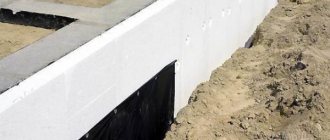High-quality thermal insulation of a house helps not only to save money, but also to increase comfort in the home. You can insulate walls both outside and inside, especially if funds for repairs are limited. There is an excellent 100% method of insulating walls from the inside with polystyrene foam + video instructions, after studying which it will not be difficult to do all the work yourself.
Method of insulating walls from the inside with foam plastic
External or internal insulation: what to choose?
When choosing one of the methods, you should pay attention to the fact that external insulation shifts the dew point, so that moisture cannot penetrate deep into the wall, where it usually freezes and destroys the material from the inside. The disadvantages of this method include a much larger volume of work, the need to carry out high-quality waterproofing of all surfaces and, as a result, the high cost of the event.
Internal insulation will cost much less. In addition, work can be carried out in any weather, while work outside can only be done on days of the year when there is no precipitation.
Conditions for insulating walls from the inside
There are certain conditions when it is possible to carry out internal thermal insulation and when it is not. If the insulation is not properly insulated, condensation appears on the walls, fungus develops under the insulation layer, and gradual destruction occurs. The formation of condensation indicates the location of the dew point, and its occurrence depends on the humidity and temperature in the house. The table will help you determine the dew point:
Dew point determination table
In addition, other factors are also important: the presence of a ventilation system, the quality of heating, the mode of operation of the home, the thickness of the load-bearing walls, and the region of residence.
Based on this, internal wall insulation can be performed under the following conditions:
- people live in the house permanently;
- the ventilation system fully meets established standards;
- heating works without failures;
- insulation is planned for all surfaces;
- the walls always remain dry.
In all other cases, only external thermal insulation is allowed.
Prices for thermal insulation materials
Thermal insulation materials
Why foam plastic?
This material is one of the most common, so acquiring it will not be a difficult problem to solve. Moreover, polystyrene foam has characteristics that are important for the intended purpose. Such as:
- Good sound insulation.
- Excellent thermal insulation properties.
- Light weight.
- Easy to process and install (easy to cut and attach to wall surfaces).
- Resistant against mold and fungal organisms.
- Durability. The material is not afraid of severe frosts, heat, and temperature changes.
- Moisture resistance. Polyfoam does not absorb moisture, so it does not need additional waterproofing. The moisture resistance of the material is easy to check - to do this, just immerse the sheet in water for 7-10 days. During this time, it will absorb moisture no more than 0.3-0.4% of the volume of the sheet.
The disadvantages of polystyrene foam include its low strength, so when using this material it will be necessary to protect the material from a variety of mechanical damage.
Another disadvantage is the flammability of the material. It can withstand temperatures no higher than 600°C. A simple example will help you understand how little this is: the flame of a lighted match has a temperature of 750°C. In addition, the material has low adhesive properties, therefore, in addition to glue, it will need to be additionally fixed to the insulated surface.
What is important is that the use of polystyrene foam will reduce the usable area of the room, which is also a disadvantage.
Advantages and disadvantages of expanded polystyrene
The technical characteristics of expanded polystyrene indicate the maximum suitability of the material for internal insulation:
- Light weight. The material is 98% gas.
- Vapor tightness. Polystyrene is an excellent vapor barrier, and extruded polystyrene foam - EPS - almost completely eliminates the penetration of water vapor through its thickness.
- Low thermal conductivity . The presence of air bubbles ensures high heat retention.
- Lack of response to moisture.
- Durable, easy to cut, produced in an easy-to-work form - slabs.
- In terms of fire, the material is neutral ; it burns only in the presence of an initiating flame; it itself cannot be a source of fire.
- Low price (for XPS this point is not entirely correct, but the quality of the material is worth it).
There are also disadvantages:
- With sufficiently high strength, EPS is fragile and breaks or crumbles under deforming loads.
- Does not withstand contact with solvents such as gasoline or acetone.
- When heated above 60 degrees, PPS can release phenols.
- It is afraid of fire, therefore it is not recommended for indoor installation.
Comparison of thermal insulation materials
The last point is quite significant, since the insulation of external walls is carried out around heating radiators, which can significantly heat the insulation areas located in the immediate vicinity. Another disadvantage of PPS is its vapor permeability, but in the case under consideration this is precisely an advantage.
Features of choosing the right foam
Polystyrene foam is a gas-filled or foamed plastic in which air occupies the main volume. It is the presence of air in a larger volume that gives the material excellent thermal insulation characteristics. Depending on the raw materials used and the method of manufacturing the canvases, there is a division of foam into the following varieties:
- Polyurethane.
- Polystyrene.
- Phenol-formaldehyde.
- Polyvinyl chloride and others.
The most popular polystyrene foam today is polystyrene. It is produced in unpressed and pressed ways. For insulation, polystyrene material made without pressing is used. When choosing insulation, you must pay attention to its labeling. For example, the designation PSB-S-15 should be read as follows:
- PS – polystyrene type;
- B – non-pressed manufacturing method;
- C – self-extinguishing;
- 15 is an indicator of density, which is measured in kg/m³.
This brand of polystyrene foam is intended for insulation of roofs without attics and attics. To insulate residential premises, facades, loggias, balconies, it is worth using material with a density of 25 kg/m³ (PSB-S-25). Foam plastic with a density of 35 kg/m³ is designed for thermal insulation of foundations, durable and resistant even to harsh weather conditions. Insulation with a density of 50 kg/m³ has the highest strength and stability. It is used for thermal insulation of floors in basements, garages, industrial premises, etc.
Based on this, it can be noted that density is the main criterion for choosing foam insulation. But there are several more important criteria on which the quality of the material depends, namely:
- Storage conditions. If at the point of sale the insulation lies directly in the sun, its thermal insulation properties will be impaired.
- Appearance. The material must only be white. If there are yellow spots on it, this is evidence that poor quality raw materials were used for production or storage conditions were violated.
- No foreign odors. If there are any, then this indicates a violation of the manufacturing technology.
The quality of the material is also indicated by the presence of a manufacturer’s marking or sticker. A reliable manufacturer, for whom its reputation is important, will certainly provide the necessary conclusions and certificates. If the seller cannot show them, this is already a reason to think about the advisability of purchasing insulation from this supplier.
What and how is foam made from?
When talking about the dangers of this material, several questions are usually asked:
- is foam plastic indoors harmful to human health;
- is it possible to use polystyrene foam for insulation and whether such insulation will cause harm to the house;
- how to properly insulate a house with polystyrene foam.
To answer these questions, you need to understand what the material is and what its properties are. Already from the name it is clear that it is produced by foaming plastics. So where does the harm come from? After all, no one refuses to use plastic products indoors? And they should be even more harmful, since the density of the material is higher. Accordingly, the concentration of harmful substances should also be higher.
However, the vast majority of people use household appliances, electronic devices, and pieces of furniture, which certainly contain plastic parts. But only the safety of using foamed plastics is questioned. And more often when they are used as insulation.
At one time, foam plastics were obtained from almost all types of plastics: polyurethane, PVC, phenol-formaldehyde plastics, polystyrene. These compounds, not yet foamed, are present in every home as part of household items, and do not in any way threaten the health and life of the residents. Of course, with proper use.
Preparing the walls
If there are remnants of previously applied finishing on the walls, it is completely removed. Next, the surfaces are inspected to identify and mark the largest cracks, depressions, and protrusions. Using a level or plumb line, mark the places with the greatest difference in unevenness.
If the house was built with high quality, the errors are insignificant and can be easily eliminated by applying a thicker layer of adhesive. If the errors are significant, then the depressions are leveled with plaster, and the bulges are trimmed off with an ax or other tool. If this is not possible, you will have to cut a notch on the foam sheet in the place opposite the convexity.
If there are cracks near the window openings or near the door, they must be filled with putty, otherwise the insulation work may be useless. In order for the glue to better adhere to the wall surface, it is necessary to apply 2-3 layers of deep penetration primer. Experts also recommend applying an antifungal additive first. How to prepare and apply the mixture is indicated on the packaging.
Is it worth insulating a house with polystyrene foam from the inside?
Foam plastic is one of the most suitable materials with which you can insulate a wooden house both from the inside and outside.
The resulting sheathing will provide a high level of insulation, and, if necessary, it can be sheathed on the inside with plasterboard.
House insulated with polyurethane
The presented material is inexpensive, has high thermal insulation characteristics, and can be used to sheathe the outside and inside of a wall in the shortest possible time. We also recommend buying polystyrene foam in Khabarovsk.
Installation of foam plastic
First of all, prepare the adhesive according to the instructions. Then they begin to glue the foam sheets in small areas: the spaces above and below the windows, behind the radiators, etc.
To do this, carefully measure the surface and, based on the data obtained, cut out the desired element, check its accuracy by applying it to the wall. Glue is applied to the entire area of the foam sheet in a thin layer or dotted in the center and along the entire perimeter, applied to the surface, firmly pressed against the wall and lightly tapped on its surface.
The sheets are laid in a checkerboard pattern, starting from the bottom of the wall. This must be done extremely carefully in order to get the surface as even as possible - this will save you from the work of further leveling them. At the same time, they carefully monitor that the foam sheets fit one to the other as tightly as possible.
Brief characteristics of polystyrene foam
Expanded polystyrene is a hard, white, porous material. The peculiarity of its production is processing at high temperatures.
Styrene granules are filled with gas and the mass formed in the process is heated by steam. The air in the pores is reduced, the granules increase in volume.
Main characteristics:
- noise absorption;
- energy saving;
- water resistance;
- high strength;
- lightness of the material;
- resistance to chemicals and microorganisms;
- non-toxic.
Physical and technical properties of expanded polystyrene.
Conclusion
To perform high-quality insulation of walls from the inside, you don’t have to turn to specialists for help: all the work can be done yourself if you have experience working with simple materials and tools.
You can carry out work on laying polystyrene foam both in the house and in utility rooms that are not heated. If heat leakage continues, it is necessary to insulate the ceilings and floors: only a set of measures will help protect the house from the penetration of cold.
Is foam plastic indoors harmful to human and animal health?
To figure out whether polystyrene foam is harmful indoors, let’s read the most common statements of opponents of this material:
- polystyrene foam emits toxic gases when burned;
- expanded polystyrene - one of the types of foam plastic, emits styrene, which remains in the material after production and is very toxic;
- polystyrene foam has low vapor permeability - it does not breathe, so harmful water vapor accumulates in a sealed house, mixed with toxins released from the material;
- Styrofoam is eaten by mice and other rodents.
Now let’s try to think about whether there is logic in these statements.
Application of foam plastics
Let's start with the fact that not any foam plastic is used in construction, but only polystyrene foam. It is officially approved for use as insulation. It is also used to make packaging for goods, including food and medicine. The material is included in the register of goods subject to state registration. Disposable tableware is made from polystyrene. It is even possible to heat food placed in it in a microwave oven.
Expanded polystyrene
Polyurethane foam is also a foam plastic, known to many as foam rubber. However, no one considers it harmful when sleeping on a mattress or sitting in a chair filled with this material.
Polyvinyl chloride foam is used for the manufacture of shock-absorbing inserts, soundproofing pads, and vibration protection devices.
Some types of foam, such as phenol-formaldehyde, can actually be harmful to health. Formaldehyde contained in the composition can cause allergies and irritation. At one time, such foam plastics were also used in construction to fill voids and gaps. However, they have now been replaced by polyurethane foam.
Well, since only one of the types is widely used in construction, it is worth figuring out whether polystyrene foam is harmful to humans.
Is polystyrene foam harmful indoors?
The main question: does polystyrene foam emit harmful substances? Yes, it releases toxic gases when burned or even when heated. Is there any material that does not emit toxic gases when burned? I know only one so far - ethyl alcohol, but it cannot be used as a building material. The much-vaunted “eco-friendly” tree also emits benzopyrene when burning and even when smoldering - a typical carcinogen that is hazardous to health even in low concentrations. And cellulose also suffers from the same thing. But building materials are not used to set them on fire.
Expanded polystyrene may indeed contain toxic styrene, which has an irritating and carcinogenic effect. Chronic styrene intoxication affects the central and peripheral nervous systems, hematopoietic system, and digestive tract.
But all this is only until the styrene polymerizes and becomes solid. Yes, yes, dangerous styrene is a liquid. And under the influence of substances participating in the reaction, it stabilizes and becomes solid polystyrene. But styrene enters the body by inhalation through the mucous membranes of the eyes, nose and pharynx. Well, who would think of gnawing it, except maybe mice? By the way, it’s not difficult to protect the material from them.
Of course, at temperatures around 300°C, styrene is reduced from its solid state and becomes harmful. But it is unlikely that at an ambient temperature of 300°C anyone will claim a healthy environment. Styrene poisoning will occur much later than burns that are incompatible with life.
So is polystyrene foam harmful to health? Of course, under certain conditions it is harmful. But even the most harmless object can pose a danger in a certain situation. You just need to exclude the possibility of such a situation occurring. It is unlikely that anyone is interested in setting fire to their home.
And another frequently asked question: are foam ceiling tiles harmful? The answer is the same. The tile itself cannot be harmful unless it is heated. This means it’s not the tiles that are harmful, but the fire.
Is insulating a house with foam plastic harmful to health?
Read about the need and requirements for ventilation in the article “Ventilation in the House.”
What do developers usually see as problems after insulating a house with polystyrene foam? For some reason, many people believe that a house should breathe. This is certainly true. But the material prevents this. But the house must breathe through the ventilation system, and not through the walls or ceiling. Otherwise, the whole insulation process will lose meaning. If the insulation and enclosing structures do not interfere with air exchange, then the temperature inside and outside will be the same.
Read about insulation, vapor barrier and more in the article “House insulation. General information"
Proper insulation of a house with polystyrene foam, like other materials, must be impermeable to air. For this purpose, a vapor barrier is specially installed - a continuous vapor-tight membrane on the inside of the wall or ceiling. Its purpose is to prevent water vapor from passing from the room into the insulation.
And this is precisely the answer to the question of whether harmful gases from polystyrene foam penetrate into the room. Of course not - the vapor barrier will not let them through. Moreover, even without a vapor barrier with external insulation, evaporation will never enter the house, since the partial air pressure inside is higher. It will squeeze the vapor out.
Based on the above, we can conclude that when used correctly, the material is completely harmless to health. We’ll look at how it affects building structures in the next section.
Glue
Most often, a special adhesive is used for polystyrene foam boards, which is a cement-based dry mixture.
If the wall surface is flat, the difference is no more than 5 mm, then you can apply a continuous layer of glue with a notched trowel.
If there are more irregularities, glue is applied around the perimeter in the form of a strip 3-4 cm wide.
Several beacons with a diameter of about 10 cm are made in the middle part of the slab. After pressing to the base, the glue should cover at least 40% of the plane of the sheet.
There is another option - polyurethane adhesive in aerosol packaging. It does not require additional preparation.
The balloon is inserted into the mounting gun, then a strip of glue is applied around the perimeter of the sheet, 2-4 cm from the edge. A zigzag stripe is applied inside the resulting rectangle. This glue allows you to install foam sheets much faster.
Work order
The text below describes the procedure for successfully insulating walls with foam plastic, both outside and inside. If you do not have an OP, we recommend hiring specialists. Approximate prices for wall insulation with foam plastic are given in the table.
Penoplex (extruded polystyrene) has a smooth surface. You can make it rough to ensure adhesion with glue in the following ways:
Ordinary polystyrene foam has a fairly rough surface and does not require preparation.
Installation of the base profile
A base profile is fixed along the bottom of the wall. It serves as the basis for the sheets of the first row, and also protects the insulation from rodents. Its size must correspond to the width of the insulation.
It is necessary to leave a distance of 2-5 mm between the profiles to compensate for the thermal expansion of the material.
Attaching foam to glue
The sheets are installed in the corners, aligned in the vertical and horizontal planes. Level and rule are used for alignment.
A cord is stretched along the upper edge of the sheets. It determines the position of the top edge of the insulation when filling the current row.
Once the sheet is in place, it must not be moved. If this is really necessary, the sheet should be removed, cleaned of glue and the entire gluing procedure must be performed again.
The sheet is applied to the wall with a slight offset from its final position.
Using a rule or a long trowel, it is pressed into the plane of adjacent slabs. Checked by level. The entire row is covered in this way.
At the corners, a serrated connection of sheets is made - sheets of adjacent rows are alternately wedged into the plane of the adjacent surface to the thickness of the insulation or a little further. After the corner is completely closed, the foam must be trimmed.
The vertical seams of adjacent rows must be at a distance of at least 20 cm from each other, that is, the seams must be bandaged.
There is a pause in work so that the glue sets securely. Usually this is three days.
Fixing with dowels
The sheets are additionally fixed using umbrella dowels, usually 5 per sheet. Their length should ensure penetration into the wall by at least 5 cm. Recesses for fastening are drilled with a hammer drill.
The dowel is driven in with a rubber hammer or screwed in with a screwdriver.
The first dowel is driven into the center of the sheet, the rest - in the corners, in the seam. The cap must be flush with the foam, the permissible protrusion is no more than 1 mm.
Completing the gluing phase
The joints of the sheets are rubbed with glue.
If there are gaps wider than 5 mm, they are foamed with polyurethane foam or sealed with strips of polystyrene foam.
If unevenness is visible, they are leveled with a foam grater.
When laying two layers of insulation, the second one is attached with vertical and horizontal overlap of the seams of the first layer. The seams of the first layer do not need to be foamed.
Fastening the reinforcing mesh
A reinforcing fiberglass mesh is fixed on top of the foam using glue.
First, the corners of the house, as well as the outer corners of window and door slopes on the first floor, are strengthened with a perforated corner, plastic or aluminum. This is done to protect against accidental damage.
If there are no corners, you can glue a strip of reinforcing mesh extending 20 cm onto each side of the corner.
Then the rest of the wall is reinforced:
The mesh is cut into strips of equal length. A 2 mm layer of glue is applied to a section of the wall according to the size of the strip. The strips are glued horizontally. The mesh is embedded in the glue layer with a wide spatula. Another layer of glue is applied on top. The stripes should overlap by 10 centimeters. The next day the surface is sanded.
If necessary, it is leveled. After 3 days the walls will dry completely. They should be primed with a mixture of quartz sand. This ensures high adhesion for subsequent coating layers
Next, the outer layer of the facade is applied, which is a decorative and protective coating. This is usually structural plaster. But you can also paint it with facade paint.
If the walls are made of wood
Some experts express the opinion that wooden walls cannot be insulated from the outside with foam plastic using the bonded thermal insulation method, because the vapor permeability of this insulation is insufficient. Such insulation can lead to dampness and deterioration of the thermal insulation properties of the walls.
They propose to make a hinged ventilated facade.
We draw your attention to the fact that sawdust and ecowool are excellent materials for insulating wooden houses.
Sawdust is inferior to ecowool as insulation, because it is not fire safe and rodents can grow in it.
However, ecowool also has disadvantages, which you can find out here.
If you don’t want to bother with insulation, build a warm Canadian house, the construction of which is described here. It is based on sip panels, which are known for already containing insulation in the form of foam plastic.
Insulation of walls from the inside with foam plastic
When using a material such as polystyrene foam to insulate the walls inside, it is necessary to take into account that there is a danger of not getting a good result. The dew point may move closer to the inner surface of the walls, then their freezing will increase.
It is necessary to make preliminary thermal calculations.
The technology of insulating walls with foam plastic on the inner surface has some features:
The entire surface of the sheet is covered with glue. This prevents the formation of air voids.
Moisture may condense in them. To level the walls, you cannot use ordinary cement mortar. Special moisture-proof mixtures are used for finishing bathrooms. Anchors are not used to avoid breaking the tightness of the layer. You can strengthen the fastening by installing between sheets of T-shaped profiles
As can be seen from the above, there are no particular difficulties in the technology of foam insulation. But the work must be done carefully. It is necessary that the insulation layer be strong and without cracks, resulting in a continuous and uniform thermal insulation shell.
Calculation of insulation thickness
It is necessary to make correct calculations of the thickness of the material. This will save usable space in the room and provide thermal insulation.
The indicator that determines the measurement is thermal resistance. If there are several layers of insulation, then the indicators for each material are summed up. The thickness of the foam is calculated by multiplying the coefficient of thermal conductivity and thermal resistance. You can use tables indicating the characteristics of thermal insulation materials or a special calculator on the Internet.
Table for calculating the thickness of insulation.
Types of expanded polystyrene
Expanded polystyrene varies depending on the manufacturing method, properties and scope of application:
- Expanded polystyrene foam. There are pressed and non-pressed ones. Pressed foam is more durable.
- Extruded foam. A synthetic material that is used in the construction of roads, sports facilities, and the manufacture of food packaging.
- Extruded polystyrene foam. High-strength waterproof material with low thermal conductivity, used for insulating houses.
- Polyurethane foam. A common example is foam rubber.
- Polyethylene foam. Elastic material used for packaging fragile items.
- Polyvinyl chloride foam. Included in construction products and materials.
Tools and materials
When foamed EPS is used to insulate walls, it is recommended to lay mineral wool mats in door and window openings.
This is done for the purpose of fire safety. It is important to observe the thickness of the gap, which must be equal to the thickness of the foam, and the width should be in the range of 200–250 mm. The density of mineral wool is desirable to be as high as possible.
An alternative to mineral wool is extruded material. It also has fire-fighting properties, but has much higher thermal conductivity, which can affect the quality of wall insulation.
To prevent the foam from starting to crumble over time, it is worth making reinforcement. To do this, you need to use a sickle mesh, which is applied to the foam plates before making the cladding. In order to reinforce all corner joints of foam plastic panels, you need a reinforcing corner measuring 50x50 mm with a serpentine, and to install the starting row you will need metal profiles.
To secure the foam to the walls you need glue.
It is commercially available in two forms: dry construction mixture, packaged in bags, and a substance similar to polyurethane foam, sold in cylinders. To secure the insulation more firmly, mushroom dowels are needed. When calculating, it is worth taking approximately 10–15 fasteners for every square meter.
To prepare the walls for foam insulation, you need to prime them.
When calculating the required amount of primer, it is important to take into account the level of porosity of the walls, as well as their material. Completely different types of soil are used for wooden, brick and concrete walls. Priming should be done in two layers.
In addition to all this, you will need other auxiliary tools. These are smooth and serrated spatulas, an electric drill with a mixer attachment, a level, a construction knife, and a container for mixing glue. You also need a hammer drill with a drill bit, the length of which will be 60–80 mm greater than the thickness of the foam, and the diameter will be 10 mm.
